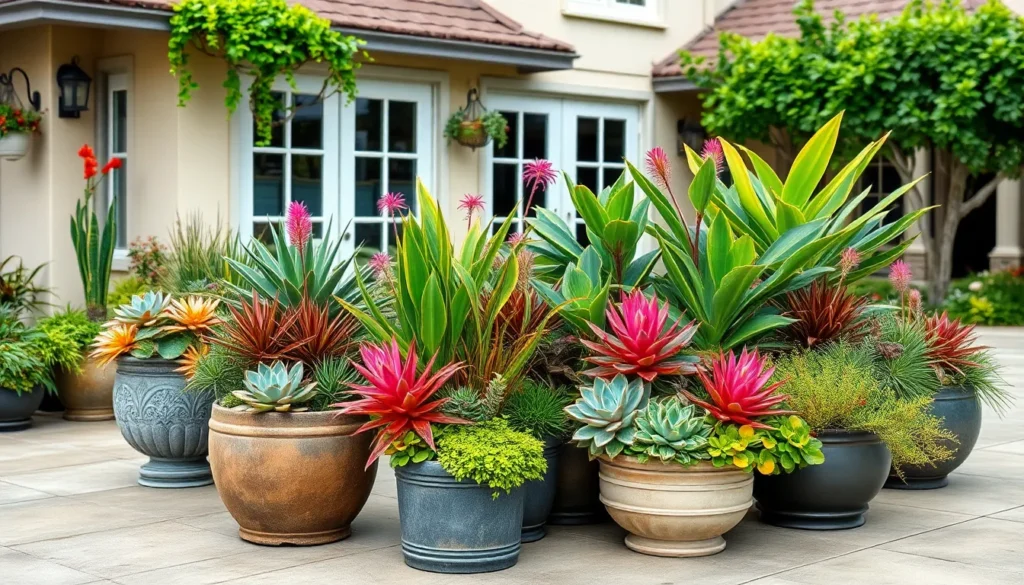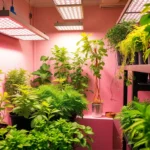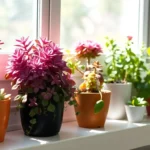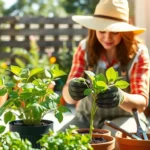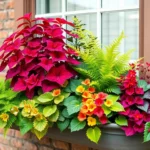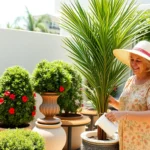Transform your outdoor space into a stunning botanical paradise with the right potted plant arrangements. We’ve discovered that strategic container gardening doesn’t just add visual appeal—it creates versatile outdoor living spaces that adapt to your lifestyle and seasonal changes.
Whether you’re working with a sprawling patio or a cozy balcony we’ll show you how to maximize every square inch with carefully chosen planters and plant combinations. From drought-resistant succulents that thrive in full sun to lush tropical plants that create privacy screens outdoor potted gardens offer endless possibilities for creativity.
The beauty of container gardening lies in its flexibility and accessibility. We can easily rearrange displays move plants to optimal lighting conditions and experiment with different heights textures and colors throughout the year. Let’s explore innovative ideas that’ll turn your outdoor area into an Instagram-worthy oasis that neighbors will envy.
Choose the Perfect Outdoor Planters for Your Space
Finding the right outdoor planters sets the foundation for successful container gardening in any space. We’ll explore essential factors that ensure your planters complement both your plants and outdoor environment.
Consider Size and Scale for Your Garden
Large planters work best for spacious patios and expansive decks where they won’t overwhelm the area. We recommend choosing containers that are at least 18 inches wide for most outdoor plants, as this provides adequate room for root development and water retention. Smaller balconies benefit from medium-sized planters ranging from 12 to 16 inches in diameter, creating visual interest without cramping the space.
Scale your planter collection to match your outdoor area’s proportions by using the rule of thirds. Place one large statement planter alongside two smaller complementary containers to create balanced groupings. We’ve found that varying heights by 6 to 8 inches between planters adds depth and visual appeal to your outdoor plant displays.
Deep planters measuring 14 inches or more accommodate root vegetables and larger flowering plants like tomatoes, peppers, and substantial perennials. Shallow containers work perfectly for herbs, succulents, and trailing plants that don’t require extensive root space.
Select Weather-Resistant Materials
Ceramic and terracotta planters offer classic beauty but require winter protection in climates with freezing temperatures. We recommend moving these containers to covered areas or wrapping them in insulation during cold months to prevent cracking from freeze-thaw cycles.
Resin and fiberglass planters provide excellent durability against harsh weather conditions while maintaining attractive appearances year-round. These materials resist fading, cracking, and temperature fluctuations, making them ideal for regions with extreme seasonal changes.
Metal planters made from powder-coated aluminum or galvanized steel withstand outdoor elements exceptionally well. We suggest choosing darker colors for metal containers as they absorb heat effectively, promoting healthy root growth in cooler climates.
Match Planter Style to Your Home’s Architecture
Modern homes pair beautifully with sleek, geometric planters featuring clean lines and minimalist designs. We recommend choosing rectangular or square containers in neutral colors like charcoal, white, or natural stone finishes to complement contemporary architecture.
Traditional homes shine with classic planter styles including decorative urns, ornate ceramic pots, and natural stone containers. These timeless designs enhance the established character of colonial, craftsman, and Victorian-style properties.
Rustic and farmhouse exteriors benefit from weathered wood planters and galvanized metal containers that echo agricultural themes. We suggest incorporating vintage-inspired designs with distressed finishes to create authentic outdoor spaces that feel naturally integrated with your home’s aesthetic.
Create Stunning Container Garden Arrangements
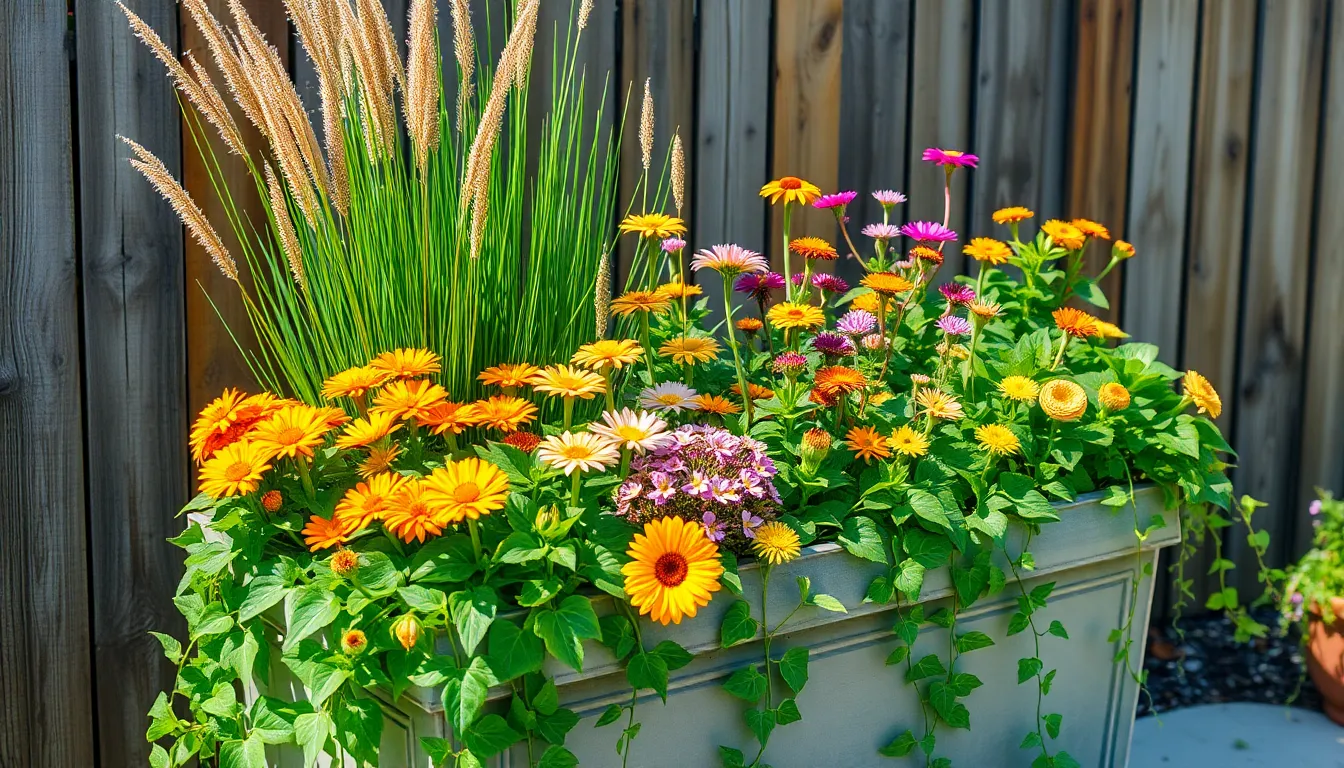
Now that we’ve selected our perfect planters, it’s time to fill them with plants that’ll create show-stopping displays. Strategic plant placement and thoughtful combinations transform ordinary containers into outdoor masterpieces.
Layer Plants by Height and Texture
Layering by height creates visual depth and ensures every plant gets its moment to shine. For containers against walls or fences, we place taller plants at the back so they don’t overshadow smaller ones. Freestanding containers work best with tall plants in the center surrounded by medium and trailing plants for a balanced 360-degree display.
Mixing textures adds incredible visual interest to our arrangements. Bold foliage paired with delicate flowers creates stunning contrast, while ornamental grasses alongside colorful blooms produce lush, inviting displays. Spiky plants combined with rounded, soft foliage generates ever-changing tension that draws the eye naturally through the arrangement.
Trailing plants spill over container edges for softness and natural flow. They connect our containers to the surrounding industry while creating movement and grace in our displays.
Mix Seasonal Flowers with Evergreen Foliage
Combining durable “keeper” plants with seasonal annuals maintains year-round appeal in our containers. Evergreen plants like ivy or ornamental grasses provide structure and consistent greenery throughout all seasons, creating a reliable foundation for our designs.
Seasonal flowers bring bursts of color and fragrance that change with the calendar. Violas and pansies brighten winter displays, while calibrachoa and sweet alyssum add summer charm. This approach keeps our containers looking fresh and seasonally appropriate without starting from scratch each season.
Structural evergreens anchor our seasonal displays and reduce maintenance. They require less frequent replacement than annuals while providing consistent visual weight and texture to balance changing seasonal elements.
Use Color Theory for Visual Impact
Warm colors like oranges, yellows, and reds create vibrant, energetic displays that command attention. We temper these bold hues with whites or greens for balance, preventing our arrangements from becoming overwhelming or chaotic.
Complementary color pairings draw the eye and enhance our garden’s overall aesthetics. Purple and yellow combinations create striking contrast, while monochromatic schemes in varying shades produce sophisticated, cohesive looks that feel intentional and polished.
Bright flower colors combined with rich foliage tones make containers visually striking and inviting. Deep burgundy leaves paired with golden blooms, or silver foliage contrasted with deep purple flowers, create professional-quality displays that rival any garden center arrangement.
Design Functional Outdoor Pot Groupings
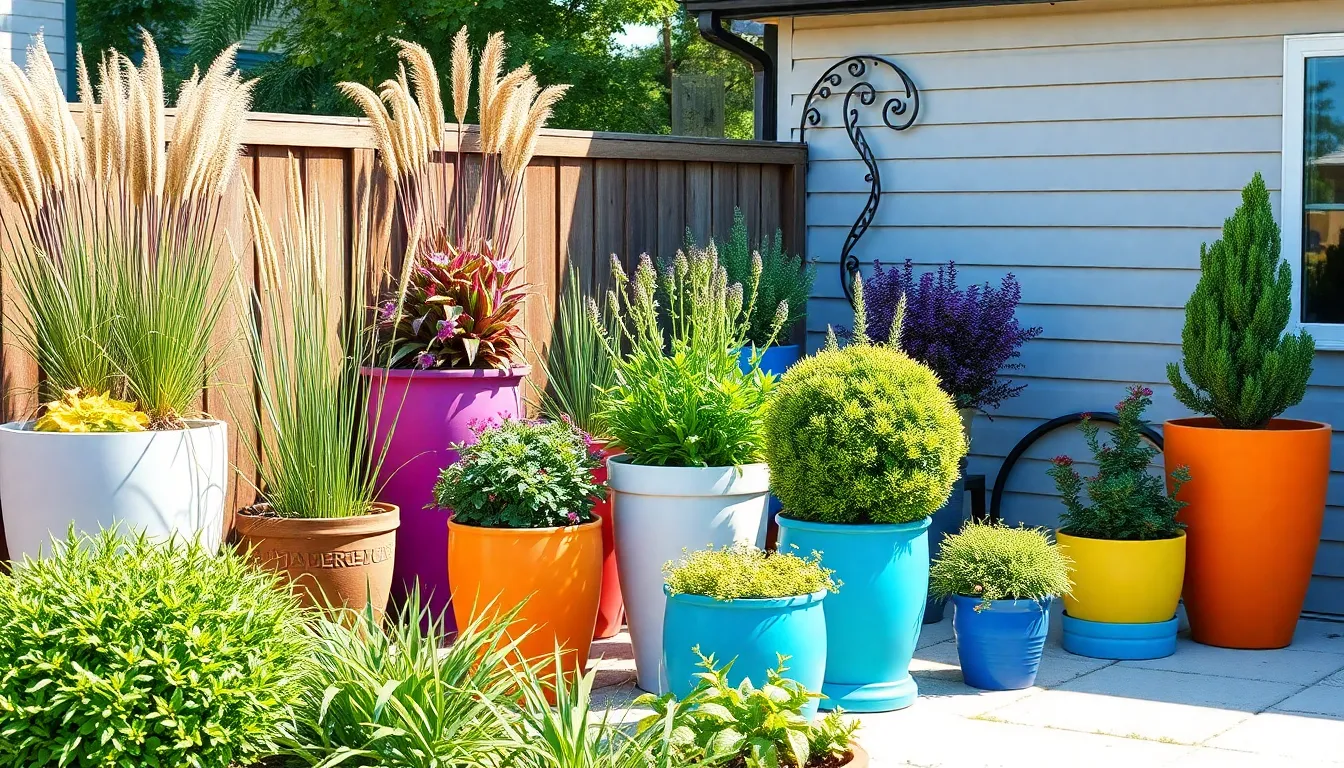
We’ll transform your outdoor space by creating purposeful container arrangements that combine beauty with practicality. Strategic placement and thoughtful plant selection make these groupings both visually stunning and highly functional.
Create Privacy Screens with Tall Planters
Position tall planters strategically along boundaries or near seating areas to shield your space without permanent construction. We recommend using metal or concrete pots for maximum durability in outdoor conditions, as these materials withstand weather extremes while maintaining their structural integrity.
Select vertical-growing plants like ornamental grasses, bamboo, or tall flowering perennials that thrive in containers and reach effective screening heights. Plants such as fountain grass, Japanese forest grass, and tall sedums create natural barriers while adding texture and movement to your outdoor environment.
Arrange multiple tall planters in a staggered formation rather than a straight line to create more visual interest and better privacy coverage. This placement technique allows plants to fill gaps naturally while providing flexibility to adjust your privacy screen as plants mature.
Build Herb Gardens Near Kitchen Areas
Group herb containers of different sizes near kitchen doors or outdoor cooking spaces to maximize convenience during meal preparation. We suggest using self-watering pots or quality peat-based potting mix with slow-release fertilizer to maintain healthy, accessible herbs throughout the growing season.
Cultivate essential cooking herbs like basil, thyme, rosemary, and parsley in separate containers to accommodate their unique root depth and spread requirements. Each herb performs best when given appropriate container space, with larger pots for spreading herbs like oregano and smaller ones for compact varieties like chives.
Create tiered arrangements using plant stands or stacked containers to maximize growing space while keeping all herbs within easy reach. This vertical approach allows us to grow more varieties in limited space while creating an attractive display that serves as both functional garden and decorative element.
Establish Focal Points with Statement Pots
Choose large, artistically designed containers with unique colors, textures, or finishes that command attention and serve as garden centerpieces. Materials like glazed ceramics, including options such as AquaPots®, offer refined colors and exceptional durability for creating standout planters that withstand outdoor conditions.
Position statement pots in high-visibility areas like entryways, patios, or garden bed centers where they naturally draw the eye and anchor your overall design. These containers work best when planted with dramatic specimens like small ornamental trees, architectural shrubs, or bold flowering plants that match the pot’s impressive scale.
Select plants proportionally to complement your statement container’s size and style, ensuring the plant choice enhances rather than overwhelms the pot’s artistic features. We recommend using plants with strong architectural forms or striking foliage that create year-round interest and justify the investment in premium containers.
Select the Best Plants for Container Gardening
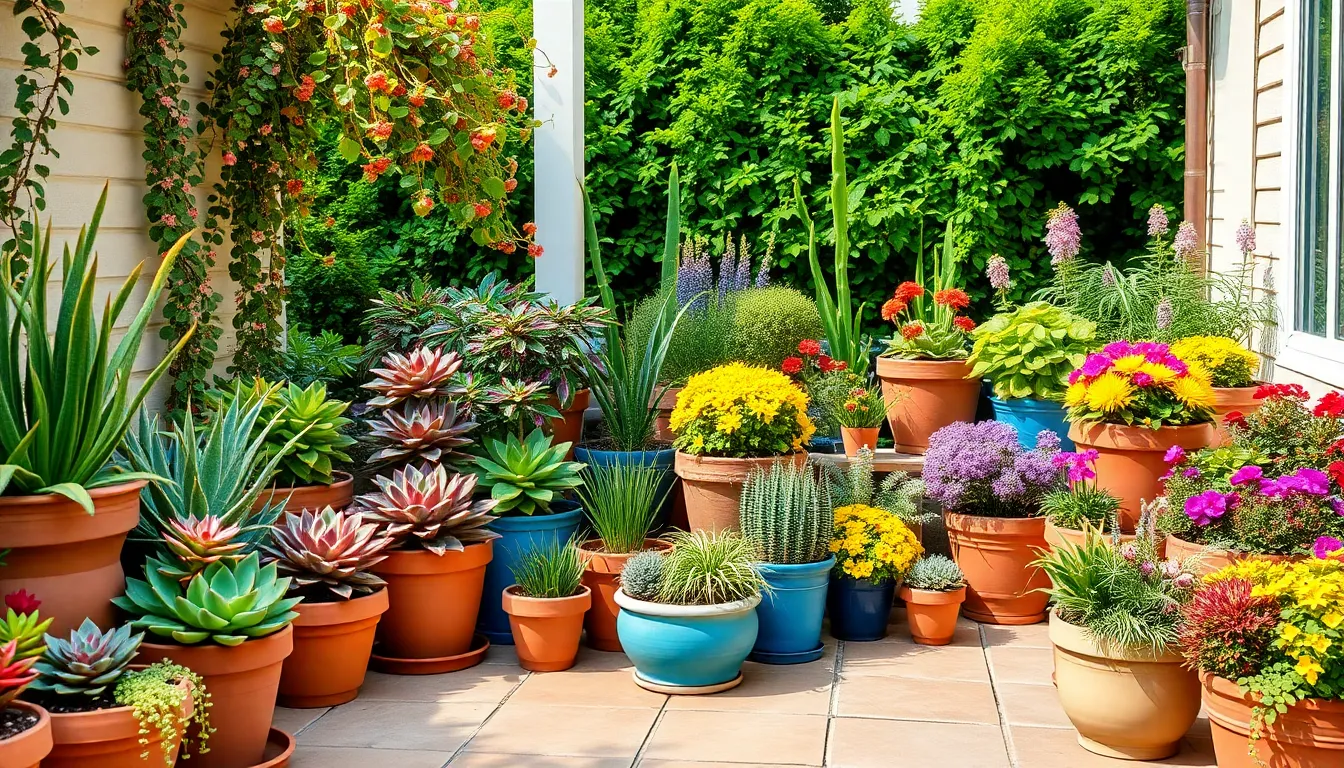
Choosing the right plants transforms your outdoor containers from simple decorative elements into thriving garden showcases. We’ll guide you through selecting varieties that’ll flourish in pots while meeting your exact gardening goals.
Choose Drought-Tolerant Varieties for Low Maintenance
Water-wise plants reduce our maintenance burden while creating stunning displays that survive dry spells. Yucca stands out as an exceptional container choice because it pairs beautifully with many other plants and tolerates neglect gracefully. These architectural plants create striking vertical elements in large planters while requiring minimal water once established.
Golden creeping Jenny offers cascading golden foliage that spills elegantly over container edges when soil moisture stays consistent. This versatile plant tolerates both sun and shade conditions, making it perfect for containers in varying light situations throughout your outdoor space.
Succulents like echeveria, sedum, and agave provide structural interest while storing water in their thick leaves. These plants create dramatic focal points in statement containers and work exceptionally well in hot, sunny locations where other plants might struggle.
Pick Plants That Thrive in Your Climate Zone
USDA hardiness zones serve as our roadmap for selecting plants that’ll survive and thrive in local conditions year after year. Japanese pieris (zones 6-8) delivers exceptional year-round interest with colorful new growth in spring and fragrant blossoms that attract pollinators. This evergreen shrub adapts to various sun exposures and container growing conditions.
Container plants face more extreme temperature fluctuations than ground-planted varieties because their roots lack soil insulation. We recommend choosing plants rated for one zone colder than your area to ensure winter survival in containers.
Sun and shade tolerance becomes critical when selecting container plants since pots can be moved to optimize growing conditions. Plants like coral bells and butterfly bush adapt to changing light conditions, giving us flexibility in arranging our outdoor displays throughout the seasons.
Combine Annuals and Perennials for Year-Round Interest
Mixing plant types creates ever-changing arrangements that evolve through seasons while maintaining consistent structure. Evergreen perennials like boxwood provide reliable backbone elements that anchor our designs year-round, while seasonal annuals add bursts of color and texture.
Tall verbena and celosia deliver months of continuous blooms when paired with structural perennials in large containers. These annuals create vibrant displays from spring through fall while evergreen companions maintain visual interest during winter months.
Layering different bloom times ensures continuous color throughout growing seasons. Early spring bulbs planted beneath summer annuals and fall-blooming perennials create succession plantings that keep containers attractive from March through November.
Trailing varieties like calibrochoa and sun coleus soften container edges while adding movement to our arrangements. These plants flow gracefully over planter rims, creating professional-looking displays that balance height and spread for maximum visual impact.
Maximize Small Outdoor Spaces with Vertical Planting
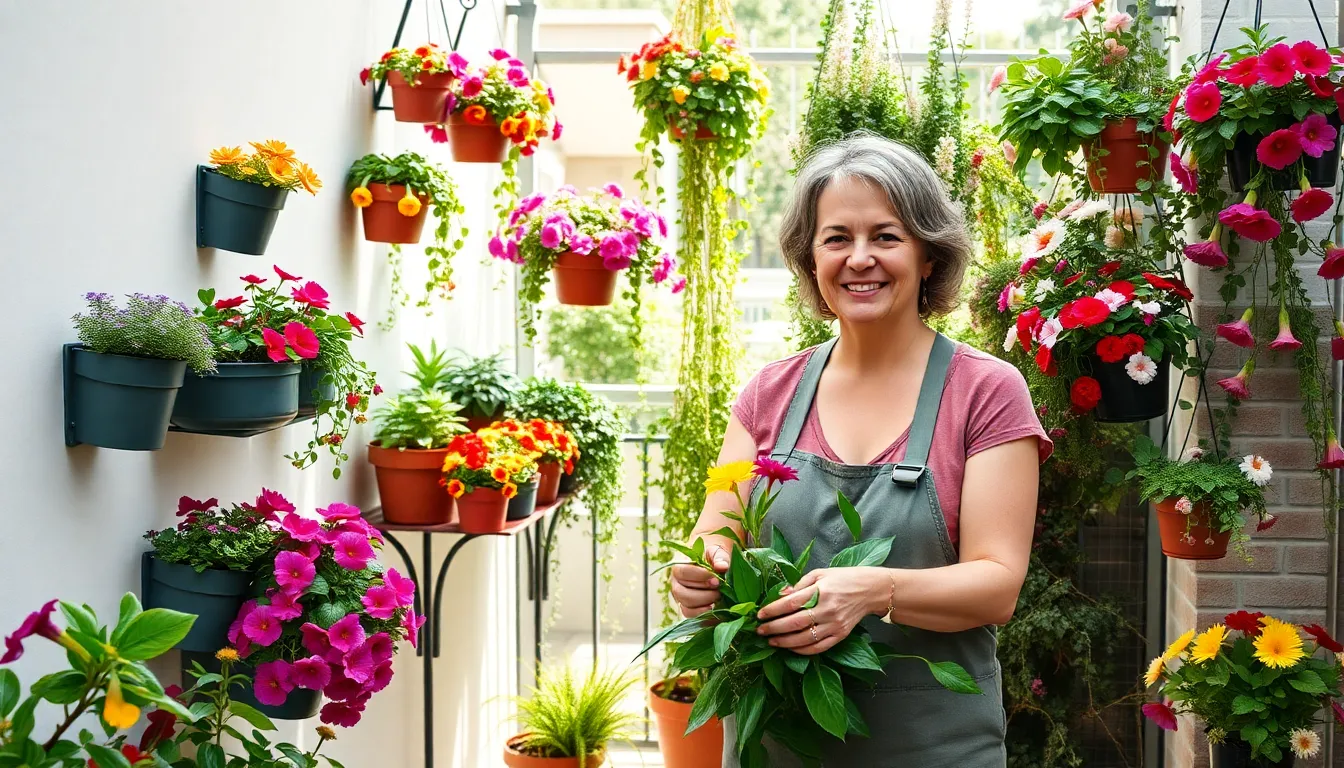
When floor space is limited, we can transform compact outdoor areas by growing upward instead of outward. Vertical planting techniques allow us to create lush, layered gardens that maximize every square inch of available space.
Install Wall-Mounted Planters for Compact Areas
Wall-mounted planters offer the perfect solution for balconies, patios, and narrow garden spaces where floor area is precious. We can attach these versatile containers to fences, walls, or railings to create stunning vertical displays without sacrificing valuable ground space.
Modern wall planters like Ella Wall Planters feature weather-resistant construction that’s UV-proof, frost-resistant, and waterproof for year-round durability. Many designs include self-watering reservoirs that reduce our maintenance tasks while keeping plants consistently hydrated. We’ll find these planters available in various sizes and colors to complement our outdoor aesthetic, often crafted from eco-friendly materials.
Creating effective wall planter displays requires strategic layering techniques:
- Use coconut coir sheets as backing material to retain moisture and provide plant support
- Layer soil and moss inside planters to create optimal rooting conditions
- Position upright species toward the back and trailing plants at the front for visual depth
- Pack soil firmly to prevent spillage and establish proper watering schedules
Use Tiered Plant Stands for Multiple Levels
Tiered plant stands enable us to stack multiple pots vertically using shelved structures that create impressive multi-level displays. These space-efficient answers work exceptionally well on porches and patios where we have some horizontal space but need to maximize our growing capacity.
We can arrange different sized containers on each tier to accommodate various plant types and create visual interest through height variation. Sturdy tiered stands support heavier pots while allowing proper air circulation and drainage for all plants. This method proves ideal for herb gardens, flower displays, or mixed succulent arrangements.
Hang Baskets to Use Overhead Space
Hanging baskets transform unused overhead areas into productive growing zones by utilizing porch ceilings, pergolas, or sturdy tree branches. We can create dramatic cascading displays that add vertical layers without occupying any floor or wall space.
Wrought iron wall basket planters provide weather-resistant options that combine decorative appeal with practical functionality. These durable containers withstand outdoor conditions while supporting trailing plants that create beautiful flowing effects. We should select hanging locations that receive appropriate light levels and remain accessible for watering and maintenance.
Strategic placement of hanging baskets at varying heights creates depth and visual movement throughout our outdoor spaces. Mix plant varieties including herbs, flowers, and succulents to develop diverse, attractive displays that maximize our growing potential in minimal square footage.
Incorporate Decorative Elements and Accessories
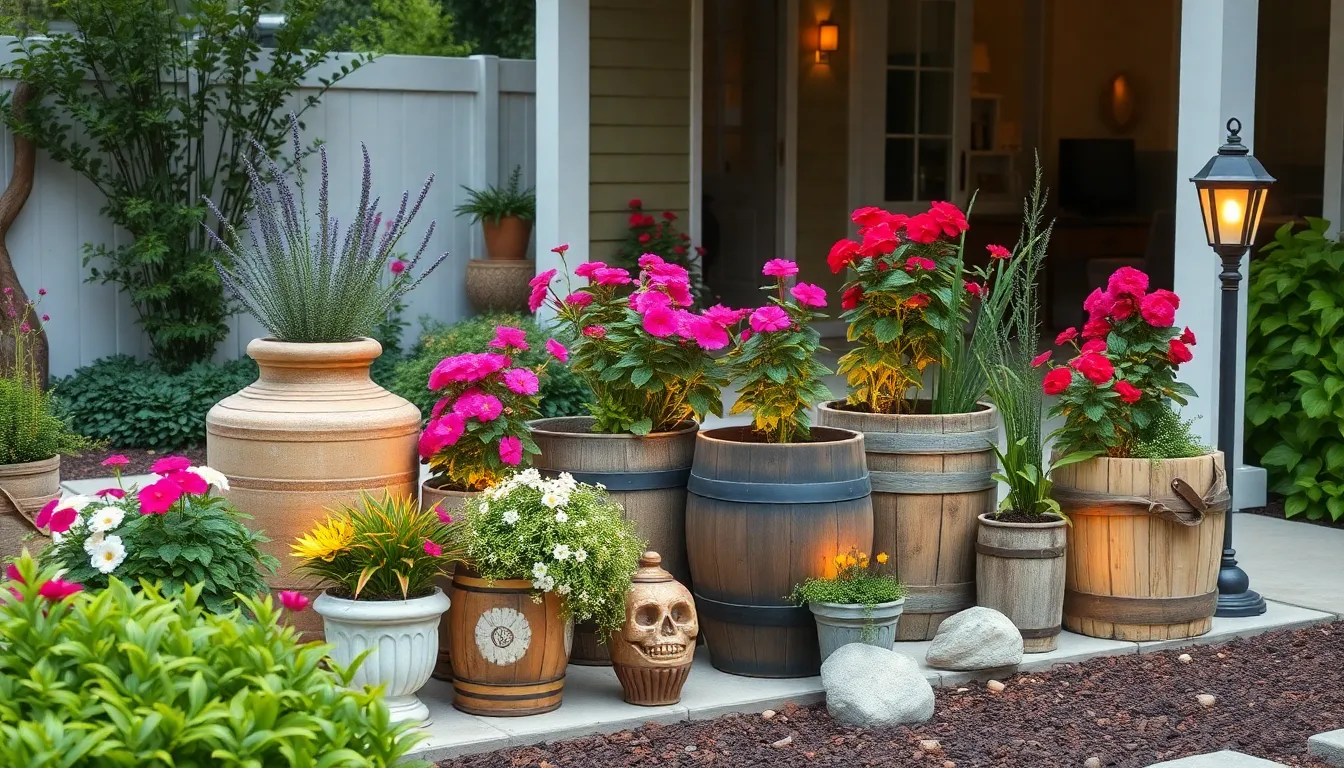
Decorative elements transform ordinary container gardens into extraordinary outdoor showcases. Creative accessories elevate the visual appeal of your potted plants while adding personality to your space.
Unique containers serve as the foundation for stunning outdoor displays. We recommend using oversized urns, aged wooden buckets, galvanized watering cans, and wrought iron bicycle plant holders to create charming garden vignettes. Decorative garden items like willow cloches and obelisks can be strategically placed in or around pots to enhance aesthetic appeal and provide structural interest.
Add Lighting for Evening Garden Ambiance
Outdoor lighting extends the enjoyment of your container gardens well into the evening hours. Solar and low-voltage LED garden lights positioned near planters create soft illumination that highlights your plants’ natural beauty without overwhelming them.
Hanging planters with integrated lighting systems offer dual functionality while creating dramatic focal points. Lantern-style fixtures add warmth and elegance to patios and porch areas where your containers are displayed. String lights woven through larger plants or draped around container groupings create magical evening atmospheres that invite relaxation and conversation.
Include Water Features in Large Containers
Large containers can double as stunning water features that add movement and sound to your outdoor space. Small fountains, bubbling bowls, and floating plants create soothing water sounds while attracting beneficial wildlife like birds and butterflies.
Ceramic, concrete, and metal planters work best for water features because they hold water without leaking. These durable materials withstand weather fluctuations while maintaining their structural integrity. Water features provide sensory appeal through gentle sounds and visual movement that enhance the overall garden experience.
Use Mulch and Decorative Stones for Finishing Touches
Mulch and decorative stones provide the perfect finishing touches that elevate your container gardens from good to professional. These materials improve moisture retention, suppress weeds, and create polished appearances that complement any outdoor style.
Colored pebbles and river rocks offer excellent texture and visual contrast when paired with exact pot styles. We’ve found that rustic terracotta pots pair beautifully with natural river stones while modern metal planters complement colored glass pebbles. These finishing materials protect soil and roots from temperature fluctuations while benefiting overall plant health throughout the growing season.
Maintain Your Outdoor Container Garden Successfully
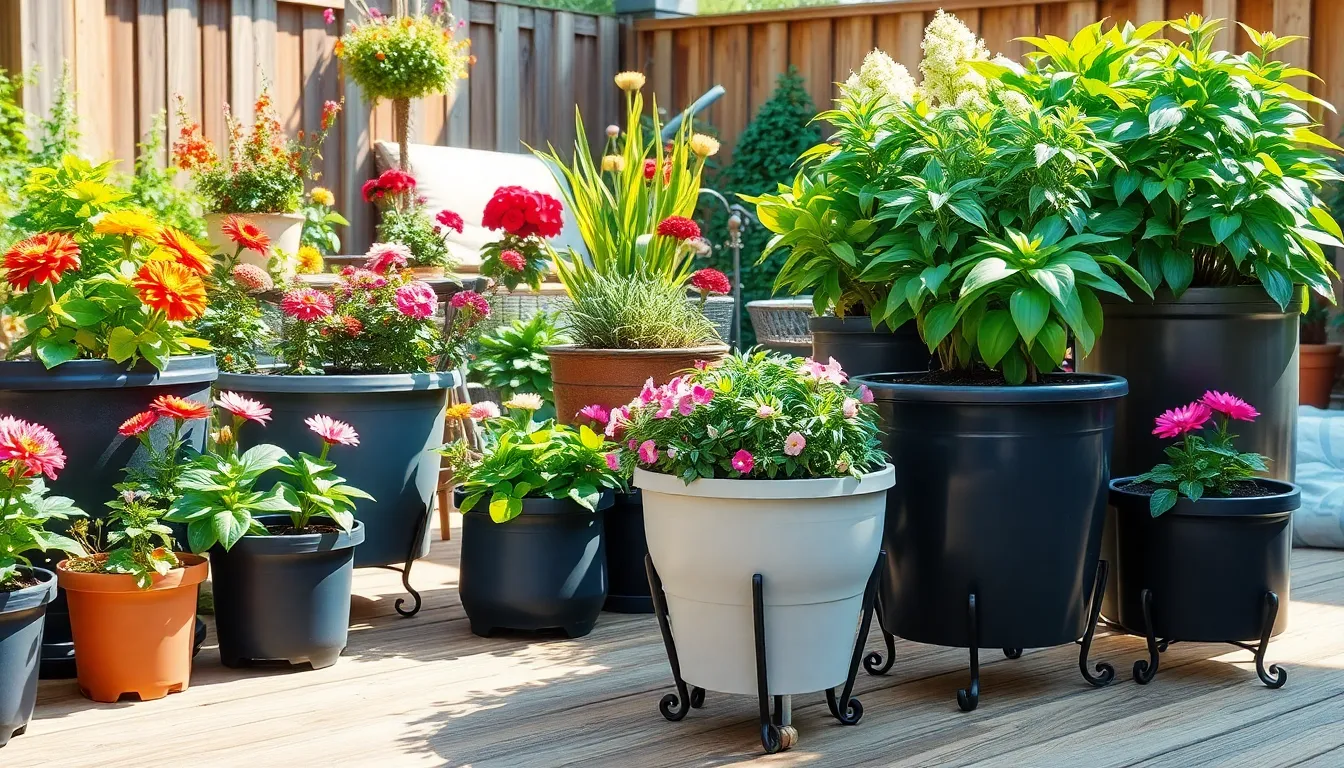
Creating beautiful outdoor potted arrangements is just the beginning of your container gardening journey. We’ll explore essential maintenance practices that keep your outdoor plants thriving throughout the seasons.
Establish Proper Watering and Drainage Systems
Water containers thoroughly when the soil surface feels dry to the touch. During hot weather, we often need to water daily since containers heat up and dry out much faster than ground plantings. Always ensure water drains from the bottom holes to reach all root zones effectively.
Avoid nighttime watering sessions to prevent foliar diseases. We recommend morning watering schedules since prolonged leaf wetness during cool evening hours increases disease risks significantly. This timing allows plants to dry before temperatures drop.
Maintain consistent moisture levels without waterlogging the soil. We should never let container soil dry out completely because this causes root damage and soil shrinkage that’s difficult to reverse. Even moisture distribution keeps plants healthy and growing strong.
Choose plastic containers over unglazed ceramic pots for better moisture retention. We’ve found that plastic materials hold water longer than porous ceramics, though all containers require frequent watering as plants mature and root systems expand.
Plan for Seasonal Plant Care and Rotation
Feed container plants with balanced slow-release fertilizer mixed into potting soil at planting time. We supplement this base nutrition with water-soluble fertilizer applications every 2-3 weeks after the first month of growth. Container plants need more frequent feeding than garden plantings since nutrients wash away with regular watering.
Prune dead and leggy growth regularly to encourage healthy new shoots. We trim overgrown stems periodically to prevent plants from becoming unruly and to maintain attractive shapes. This practice redirects energy into vibrant new growth rather than maintaining weak branches.
Rotate seasonal plantings to keep displays fresh and interesting year-round. We swap out spent annuals for new varieties that suit current weather conditions and color schemes. This rotation keeps our container gardens looking professionally maintained.
Protect Plants from Harsh Weather Conditions
Select hardy drought-tolerant varieties that withstand temperature extremes and dry spells. We choose plants like succulents, ornamental grasses, and Mediterranean herbs that naturally cope with container stress and heat exposure. These resilient varieties require less intervention during challenging weather.
Shelter sensitive plants during extreme weather events like storms or heat waves. We move vulnerable containers to protected areas such as covered patios or garage spaces when temperatures become dangerous. Outdoor container plants face more environmental stress than protected garden beds.
Monitor plants closely for pest and disease issues that increase during weather stress. We inspect leaves and stems regularly since outdoor container plants are more susceptible to problems when weakened by harsh conditions. Early detection prevents minor issues from becoming major problems.
Conclusion
We’ve explored the endless possibilities that container gardening brings to outdoor spaces. From selecting the right planters to creating stunning arrangements these techniques help us transform any area into a beautiful retreat.
The key lies in combining functionality with aesthetic appeal. Whether we’re working with a spacious patio or a compact balcony strategic placement and thoughtful plant selection make all the difference.
Remember that successful container gardening isn’t just about the initial setup. Regular maintenance and seasonal adjustments ensure our outdoor displays remain vibrant and healthy throughout the year.
With these ideas and techniques we can confidently create outdoor container gardens that reflect our personal style while maximizing our space’s potential.
Frequently Asked Questions
What is container gardening and why is it beneficial for outdoor spaces?
Container gardening involves growing plants in pots, planters, or other containers rather than directly in the ground. It’s beneficial because it offers incredible versatility and adaptability for any outdoor space, from large patios to small balconies. You can easily rearrange plants, experiment with different combinations, and create visually appealing displays that can be modified seasonally.
What types of plants work best for outdoor container gardens?
A mix of drought-resistant succulents and lush tropical plants creates diverse, interesting arrangements. Combining seasonal flowers with evergreen foliage provides year-round appeal. Choose plants that suit your climate and maintenance preferences, considering factors like sun exposure, watering needs, and growth habits for the best results.
How do I choose the right size planters for my outdoor space?
Select planter size based on your available space and intended use. Large planters work well for spacious patios and can accommodate bigger plants or multiple plantings. Medium-sized planters are perfect for smaller balconies or as accent pieces. Consider the mature size of your plants and ensure adequate root space for healthy growth.
What materials are best for outdoor planters?
Weather-resistant materials are essential for outdoor planters. Ceramic and terracotta offer classic appeal but may crack in freezing temperatures. Resin and fiberglass planters are lightweight and durable. Metal planters provide modern aesthetics and excellent durability. Choose materials that complement your home’s architecture and can withstand your local climate conditions.
How can I create visual depth in my container garden arrangements?
Layer plants by height and texture to create visual depth. Place taller plants in the back or center, medium-height plants in the middle, and trailing or low plants in front. Mix different textures like smooth succulents with feathery grasses or broad-leafed plants with fine-textured varieties for added visual interest.
What color combinations work best for container gardens?
Use color theory to enhance visual impact. Warm colors like reds, oranges, and yellows create vibrant, energetic displays. Cool colors like blues, purples, and greens provide calming effects. Complementary color pairings (opposite on the color wheel) create striking contrasts, while analogous colors (next to each other) offer harmonious blends.
How can I make my container garden functional as well as beautiful?
Design functional groupings by using tall planters as privacy screens and establishing herb gardens near kitchen areas for convenient cooking access. Create statement focal points with unique pots, and consider vertical planting techniques to maximize small spaces. Incorporate seating areas and pathways to make your garden both practical and inviting.
What decorative elements can enhance my container garden?
Transform your container garden with unique containers like vintage barrels or modern geometric planters. Add outdoor lighting such as string lights or solar spotlights to extend enjoyment into evening hours. Consider incorporating water features like small fountains, decorative stones, garden sculptures, or colorful plant stakes for extra visual appeal.
How often should I water my outdoor container plants?
Water container plants in the morning to prevent diseases and allow plants to absorb moisture before the heat of the day. Check soil moisture daily by inserting your finger into the soil – water when the top inch feels dry. Container plants typically need more frequent watering than ground plants, especially during hot weather.
How do I maintain my container garden throughout the seasons?
Maintain consistent moisture levels and ensure proper drainage to prevent root rot. Fertilize regularly during growing season, prune dead or damaged growth, and rotate seasonal plantings for fresh displays. Protect plants from harsh weather by moving containers to sheltered areas or using plant covers. Monitor regularly for pests and diseases.

